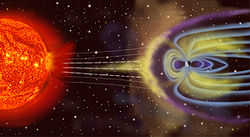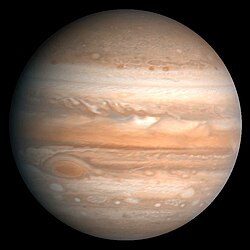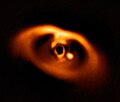Planetary science

| Part of a series of |
| Geophysics |
|---|
 |
Planetary science (or more rarely, planetology) is the scientific study of
There are interrelated observational and theoretical branches of planetary science. Observational research can involve combinations of
Planetary scientists are generally located in the astronomy and physics or Earth sciences departments of universities or research centres, though there are several purely planetary science institutes worldwide. Generally, planetary scientists study one of the Earth sciences, astronomy, astrophysics, geophysics, or physics at the graduate level and concentrate their research in planetary science disciplines. There are several major conferences each year, and a wide range of peer reviewed journals. Some planetary scientists work at private research centres and often initiate partnership research tasks.
History
The history of planetary science may be said to have begun with the Ancient Greek philosopher Democritus, who is reported by Hippolytus as saying
The ordered worlds are boundless and differ in size, and that in some there is neither sun nor moon, but that in others, both are greater than with us, and yet with others more in number. And that the intervals between the ordered worlds are unequal, here more and there less, and that some increase, others flourish and others decay, and here they come into being and there they are eclipsed. But that they are destroyed by colliding with one another. And that some ordered worlds are bare of animals and plants and all water.[2]
In more modern times, planetary science began in astronomy, from studies of the unresolved planets. In this sense, the original planetary astronomer would be Galileo, who discovered the four largest moons of Jupiter, the mountains on the Moon, and first observed the rings of Saturn, all objects of intense later study. Galileo's study of the lunar mountains in 1609 also began the study of extraterrestrial landscapes: his observation "that the Moon certainly does not possess a smooth and polished surface" suggested that it and other worlds might appear "just like the face of the Earth itself".[3]
Advances in
The Solar System has now been relatively well-studied, and a good overall understanding of the formation and evolution of this planetary system exists. However, there are large numbers of unsolved questions,[4] and the rate of new discoveries is very high, partly due to the large number of interplanetary spacecraft currently exploring the Solar System.
Disciplines
Planetary science studies observational and theoretical astronomy,
Planetary astronomy
This is both an observational and a theoretical science. Observational researchers are predominantly concerned with the study of the small bodies of the Solar System: those that are observed by telescopes, both optical and radio, so that characteristics of these bodies such as shape, spin, surface materials and weathering are determined, and the history of their formation and evolution can be understood.
Theoretical planetary astronomy is concerned with
Planetary geology
In planetary science, the term geology is used in its broadest sense, to mean the study of the surface and interior parts of planets and moons, from their core to their magnetosphere. The best-known research topics of planetary geology deal with the planetary bodies in the near vicinity of the Earth: the Moon, and the two neighboring planets: Venus and Mars. Of these, the Moon was studied first, using methods developed earlier on the Earth. Planetary geology focuses on celestial objects that exhibit a solid surface or have significant solid physical states as part of their structure. Planetary geology applies geology, geophysics and geochemistry to planetary bodies.[6]
Planetary geomorphology
Geomorphology studies the features on planetary surfaces and reconstructs the history of their formation, inferring the physical processes that acted on the surface. Planetary geomorphology includes the study of several classes of surface features:
- Impact features (multi-ringed basins, craters)[7]
- Volcanic and tectonic features (lava flows, fissures, rilles)[8]
- Glacial features[7]
- Aeolian features[8]
- Space weathering – erosional effects generated by the harsh environment of space (continuous micrometeorite bombardment, high-energy particle rain, impact gardening). For example, the thin dust cover on the surface of the lunar regolith is a result of micrometeorite bombardment.
- Hydrological features: the liquid involved can range from water to hydrocarbon and ammonia, depending on the location within the Solar System. This category includes the study of paleohydrological features (paleochannels, paleolakes).[9]
The history of a planetary surface can be deciphered by mapping features from top to bottom according to their deposition sequence, as first determined on terrestrial strata by Nicolas Steno. For example, stratigraphic mapping prepared the Apollo astronauts for the field geology they would encounter on their lunar missions. Overlapping sequences were identified on images taken by the Lunar Orbiter program, and these were used to prepare a lunar stratigraphic column and geological map of the Moon.
Cosmochemistry, geochemistry and petrology
One of the main problems when generating hypotheses on the formation and evolution of objects in the Solar System is the lack of samples that can be analyzed in the laboratory, where a large suite of tools are available, and the full body of knowledge derived from terrestrial geology can be brought to bear. Direct samples from the Moon,
The different types of meteorites that originate from the asteroid belt cover almost all parts of the structure of differentiated bodies: meteorites even exist that come from the core-mantle boundary (pallasites). The combination of geochemistry and observational astronomy has also made it possible to trace the HED meteorites back to a specific asteroid in the main belt, 4 Vesta.
The comparatively few known
During the Apollo era, in the
Planetary geophysics and space physics
Space probes made it possible to collect data in not only the visible light region but in other areas of the electromagnetic spectrum. The planets can be characterized by their force fields: gravity and their magnetic fields, which are studied through geophysics and space physics.
Measuring the changes in acceleration experienced by spacecraft as they orbit has allowed fine details of the

If a planet's magnetic field is sufficiently strong, its interaction with the solar wind forms a magnetosphere around a planet. Early space probes discovered the gross dimensions of the terrestrial magnetic field, which extends about 10 Earth radii towards the Sun. The solar wind, a stream of charged particles, streams out and around the terrestrial magnetic field, and continues behind the magnetic tail, hundreds of Earth radii downstream. Inside the magnetosphere, there are relatively dense regions of solar wind particles, the Van Allen radiation belts.
Planetary
Planetary geodesy
Planetary geodesy (also known as planetary geodetics) deals with the measurement and representation of the planets of the Solar System, their
Planetary atmospheric science

An
The effects of the rotation rate of a planet about its axis can be seen in atmospheric streams and currents. Seen from space, these features show as bands and eddies in the cloud system and are particularly visible on Jupiter and Saturn.
Planetary oceanography
Exoplanetology
Exoplanetology studies exoplanets, the planets existing outside of the Solar System. Until recently, the means of studying exoplanets have been extremely limited, but with the current rate of innovation in research technology, exoplanetology has become a rapidly developing subfield of astronomy.
Comparative planetary science
Planetary science frequently makes use of the method of comparison to give a greater understanding of the object of study. This can involve comparing the dense atmospheres of Earth and Saturn's moon Titan, the evolution of outer Solar System objects at different distances from the Sun, or the geomorphology of the surfaces of the terrestrial planets, to give only a few examples.
The main comparison that can be made is to features on the Earth, as it is much more accessible and allows a much greater range of measurements to be made. Earth analog studies are particularly common in planetary geology, geomorphology, and also in atmospheric science.
The use of terrestrial analogs was first described by Gilbert (1886).[8]
In fiction
- In Liet-Kynes serves as the "Imperial Planetologist" for the fictional planet Arrakis, a position he inherited from his father Pardot Kynes.[12] In this role, a planetologist is described as having skills of an ecologist, geologist, meteorologist, and biologist, as well as basic understandings of human sociology.[12][13] The planetologists apply this expertise to the study of entire planets.[12][13] In the Dune series, planetologists are employed to understand planetary resources and to plan terraforming or other planetary-scale engineering projects.[12][13] This fictional position in Dune has had an impact on the discourse surrounding planetary science itself and is referred to by one author as a "touchstone" within the related disciplines.[14] In one example, a publication by Sybil P. Seitzinger in the journal Nature opens with a brief introduction on the fictional role in Dune, and suggests that humans should consider appointing individuals with similar skills to Liet-Kynes to help with managing their activity on Earth.[15]
Professional activity
Journals
Professional bodies
This non-exhaustive list includes those institutions and universities with major groups of people working in planetary science. Alphabetical order is used.
- Division for Planetary Sciences (DPS) of the American Astronomical Society
- American Geophysical Union
- Meteoritical Society
- Europlanet
Government space agencies
- Canadian Space Agency (CSA)
- China National Space Administration (CNSA, People's Republic of China).
- Centre national d'études spatiales French National Centre of Space Research
- Deutsches Zentrum für Luft- und Raumfahrt e.V., (German: abbreviated DLR), the German Aerospace Center
- European Space Agency (ESA)
- Indian Space Research Organisation(ISRO)
- Israel Space Agency (ISA)
- Italian Space Agency
- Japan Aerospace Exploration Agency(JAXA)
- NASA (National Aeronautics and Space Administration, United States of America)
- National Space Organization(Taiwan).
- Russian Federal Space Agency
- UK Space Agency (UKSA).
Major conferences
- Lunar and Planetary Science Conference (LPSC), organized by the Lunar and Planetary Institute in Houston. Held annually since 1970, occurs in March.
- Division for Planetary Sciences (DPS) meeting held annually since 1970 at a different location each year, predominantly within the mainland US. Occurs around October.
- American Geophysical Union (AGU) annual Fall meeting in December in San Francisco.
- American Geophysical Union (AGU) Joint Assembly (co-sponsored with other societies) in April–May, in various locations around the world.
- Meteoritical Societyannual meeting, held during the Northern Hemisphere summer, generally alternating between North America and Europe.
- European Planetary Science Congress (EPSC), held annually around September at a location within Europe.
Smaller workshops and conferences on particular fields occur worldwide throughout the year.
See also
- Areography (geography of Mars)
- Planetary cartography
- Planetary coordinate system
- Selenography – study of the surface and physical features of the Moon
- Theoretical planetology
- Timeline of Solar System exploration
References
- ^ S2CID 12316875.
- ^ Hippolytus (Antipope); Origen (1921). Philosophumena (Digitized 9 May 2006). Vol. 1. Translation by Francis Legge, F.S.A. Original from Harvard University.: Society for promoting Christian knowledge. Retrieved 22 May 2009.
- S2CID 4349517.
- ^ Stern, Alan. "Ten Things I Wish We Really Knew In Planetary Science". Retrieved 2009-05-22.
- ^ Is Extraterrestrial Life Suppressed on Subsurface Ocean Worlds due to the Paucity of Bioessential Elements?, The Astronomical Journal, 156:151, October 2018.
- ^ "Planetary Geology". Encyclopedia of Geology (Second Edition), 2021. Retrieved 12 March 2022.
- ^ S2CID 132406061.
- ^ S2CID 132406061.
- ISBN 978-1-4614-3133-6
- ^ "UW – Laramie, Wyoming | University of Wyoming".
- ^ {curator.jsc.nasa.gov/antmet/lmc/lmcintro.pdf}
- ^ ISBN 0441172717.
- ^ ISBN 0553580272.
- ISBN 978-3-8394-4751-2.
- PMID 21124410.
Further reading
- Carr, Michael H., Saunders, R. S., Strom, R. G., Wilhelms, D. E. 1984. The Geology of the Terrestrial Planets. NASA.
- Morrison, David. 1994. Exploring Planetary Worlds. W. H. Freeman. ISBN 0-7167-5043-0
- Hargitai H et al. (2015) Classification and Characterization of Planetary Landforms. In: Hargitai H (ed) Encyclopedia of Planetary Landforms. Springer. https://link.springer.com/content/pdf/bbm%3A978-1-4614-3134-3%2F1.pdf
- Hauber E et al. (2019) Planetary geologic mapping. In: Hargitai H (ed) Planetary Cartography and GIS. Springer.
- Page D (2015) The Geology of Planetary Landforms. In: Hargitai H (ed) Encyclopedia of Planetary Landforms. Springer.
- Rossi, A.P., van Gasselt S (eds) (2018) Planetary Geology. Springer
External links
- Planetary Science Research Discoveries (articles)
- The Planetary Society (world's largest space-interest group: see also their active news blog)
- Planetary Exploration Newsletter (PSI-published professional newsletter, weekly distribution)
- Women in Planetary Science (professional networking and news)

